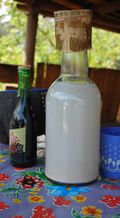Pulque
The ancient Mexicans used to cut into the agave cactus to get to the juice inside which the Spaniards called Aguamiel - "honey water". If left for a few hours, this aguamiel starts to ferment and cloud into the color of milk. This fermented aguamiel is called pulque and is roughly equivalent to beer or wine as a soft alcohol. Pulque has been the traditional drink of Mexico for over 300 years. Pulque is an alcoholic beverage made from the fermented juice of the maguey plant, or Great American Aloe, a traditional native beverage of Mesoamerica; at the time of throwing its flower stem, it is hollowed in the centre and the juice which should have supplied the flowers, is taken from it daily, for about two months; which juice when fermented is immediately fit for drinking. A very strong brandy is obtained by distillation.
The maguey plant is not a cactus (as has sometimes been mistakenly suggested) but an agave called "century plant" in the United States. The plant was one of the most sacred plants in Mexico and had a prominent place in mythology, religious rituals, and Meso-American industry.
Pulque is depicted in Native American stone carvings as early as 200 AD. The origin of pulque is unknown, but because it has a major position in religion, many folk tales explain its origins. According to Indian history, during the reign of Tecpancaltzin, a Toltec noble named Papantzin found out how to extract aguamiel from the maguey plant. In Pre-Columbian times the Aztecs consumed it at religious ceremonies.
Pulque is still made and drunk in limited quantities in parts of Mexico today. However, because it cannot easily be stored or preserved, it is not well known outside Mexico. Mezcal (or mescal) is the name given to distilled pulque. Tequila is the name of a Mezcal from the region of Mexico around the town of Tequila. Pulque is the undistilled drink.
